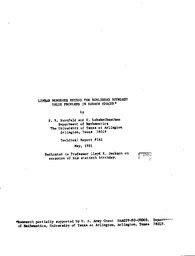| dc.description.abstract | **Please note that the full text is embargoed** ABSTRACT: One of the most useful techniques in proving the existence of multiple solutions of nonlinear boundary value problems (BVP for short) is the
monotone iterative method, which yields monotone sequences that converge to extremal solutions of the problem. Recently, because of applications,
this technique has attracted much attention, see [1,3-7,11,12,14,15]. To explain this method, let us consider the scalar BVP
(1.1) [see pdf for notation] where [see pdf for notation] and [see pdf for notation], I being the interval [0,1]. Suppose that
[see pdf for notation] with [see pdf for notation] on I and (1.2) [see pdf for notation] Then v0, w0 are called lower and upper solutions
of (1.1). Suppose also that fu, fu1 exist and f satisfies a Nagumo condition. In order to obtain monotone iterations, one considers
the auxiliary BVP (1.3) [see pdf for notation]where [see pdf for notation] for [see pdf for notation] and |u1| ^ c for some suitable c > 0
which is related to the Nagumo constant. To proceed further with monotone method it becomes necessary to show that there exists a unique
solution for the BVP (1.3). For this purpose, one proves that (i) v0,w0 are also lower and upper solutions of (1.3) and (ii) F satisfies
a Nagumo condition. Then it follows from known results [2,8,9,10,12,13] that the auxiliary BVP (1.3) possesses a solution.
The uniqueness of solutions follows by the maximum principle in view of the fact that F is linear in u and M1(c) > 0. We recall that
these known results crucially depend on the modification of f, namely f, where (1.4) [see pdf for notation] and [see pdf for notation] c > 0
being a number such that [see pdf for notation] on I. These reseults have been extended to finite and countably infinite systems of
BVP's where the inequalities between vectors are understood as componentwise, see [2,7,10,13].
If one desires to extend this attractive monotone method to BVP's in an arbitrary Banach space E, one needs to induce a partial ordering by
means of a cone K in E. Then it is easy to define lower and upper solutions and a Nagumo condition, as before. Corresponding to this setting,
we need an existence and uniqueness result for the BVP (1.3) where F is now a nonlinear function in a Banach Space. The modified function approach
followed earlier makes sense only when [see pdf for notation] and [see pdf for notation], the standard cone. Consequently the problem of proving
existence of solutions of the BVP (1.3) becomes difficult. On is faced with the problem of proving such an existence result directly by other means
(say by Lyapunov-like methods [2,8]) which need extra assumptions. Unfortunately, the results obtained in [4] for the general case, are correct
only in special Banach spaces since the modified function approach which is not valid in general, is folloed there.
However, if f does not depend on u1, the situation becomes quite simple, that is we will have (1.5) [see pdf for notation]. In view of the fact,
F is linear in u and [see pdf for notation], there results [see pdf for notation] where (x,y) is the generalized inner product and hence existence
and uniqueness of solutions of (1.5) follows from abstract results. This is precisely the method adapted in [15] for extending the monotone method
to a Banach space for the case where f does not depend on u1.
In this paper, we wish to develop the monotone method for those f that are linear in u1 by means of a linear procedure, that is, we consider the BVP (1.6) [see pdf for notation],
for [see pdf for notation] and [see pdf for notation] on I, instead of (1.3). Here M1 is as before. Unfortunately, M1 depends on c which is the bound
on |u1| which causes considerable problems since we must make sure that every solution of (1.6) for every n, satisfies |u1| ≤ c for some c > 0.
However, it turns out that these difficulties can be surmounted and the entire procedure of linear monotone method works well to our advantage. As a rich
dividend, one is pleased to have the iterates as uniqu solutions of linear BVP's (1.6) with constant coefficients instead of the solutions of nonlinear BVP (1.3)
considered so far. Thus, our results are more constructive than before as a result of computable iterates one gets in the process. We have also obtained an
extension of the results in [6] where only the scalar equation was considered. Our method would be applicable to other situations such as partial differential
equations and we plan to attemps this elsewhere. Finally, we mention that attempts are being made to remove the linearity assumption of f on u1. This
leads to two different approaches: one continues in the same spirit of this paper; the other follows the nonlinear procedure alluded to earlier in the introduction. | en |


